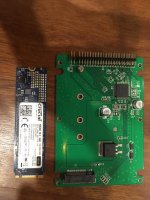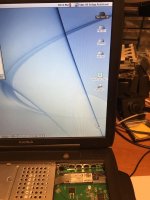AlpineRaven
Well-known member
G'day all,
I wanted to share my experience with this adapter. I wanted at least 512gb and searched for used blade SSD around that size and I found one for USD$56 it was Crucial 525gb NVMe card -> that was the cheapest available that I could find. I took a risk for NVMe m.2 card to become bootable, thinking it may not work but it did!!
Before you yarn out!! "why so big!" because I have 200gb of Legacy pre-OSX software, and approx 180gb of old early OSX software littered all over the place (on external HDDs etc) and I want to combine all into one and setup Pismo as "Middle Mac server" for file sharing/FTP etc due OSX and Mac OS 9 etc and MDD has backup.
I had issues to format it in Pismo via external (I was able to Partition into 4x 128gb, it but anything to format more than 256gb it acts funny/not 100% formatted and Mac OS 9 was able to see the partition but OSX couldn't as it'll only see 2x 128gb), so I used PowerBook G4 1.67ghz running Leopard to Format/Partition it via HDD Dock because PBG4 can accept to format larger than "128gb limit support" which Pismo is limited to 128gb -> formatted it in 3 partitions, one for Mac OS 9 (60gb), Mac OS X (40gb) and Storage (400gb) and yes Pismo can load 400gb internally as long I don't format it in Pismo as it will end up maximum of 128gb.
I bought this 44pin - m.2 adapter off ebay - put m.2 SSD in PBG4 format it, remove it and put in Pismo, installed OSX without any issues, then restart - then switch over to Mac OS 9 and install it, then restore all files back on it. I've done benchmarks, pressure copy test etc (the SSD does get warm but not hot)
Very happy with the results.
Cheers
AP
NB - I personally don't think this adapter will work in older PowerBooks before G3 Pismo, I know that mSATA - 44 card didn't work in PDQ and Lombard, so for older PowerBooks I would recommend 44 pin - SD card no questions asked. (why it didn't work in Lombard? - it freezes and crashes quite frequently)


I wanted to share my experience with this adapter. I wanted at least 512gb and searched for used blade SSD around that size and I found one for USD$56 it was Crucial 525gb NVMe card -> that was the cheapest available that I could find. I took a risk for NVMe m.2 card to become bootable, thinking it may not work but it did!!
Before you yarn out!! "why so big!" because I have 200gb of Legacy pre-OSX software, and approx 180gb of old early OSX software littered all over the place (on external HDDs etc) and I want to combine all into one and setup Pismo as "Middle Mac server" for file sharing/FTP etc due OSX and Mac OS 9 etc and MDD has backup.
I had issues to format it in Pismo via external (I was able to Partition into 4x 128gb, it but anything to format more than 256gb it acts funny/not 100% formatted and Mac OS 9 was able to see the partition but OSX couldn't as it'll only see 2x 128gb), so I used PowerBook G4 1.67ghz running Leopard to Format/Partition it via HDD Dock because PBG4 can accept to format larger than "128gb limit support" which Pismo is limited to 128gb -> formatted it in 3 partitions, one for Mac OS 9 (60gb), Mac OS X (40gb) and Storage (400gb) and yes Pismo can load 400gb internally as long I don't format it in Pismo as it will end up maximum of 128gb.
I bought this 44pin - m.2 adapter off ebay - put m.2 SSD in PBG4 format it, remove it and put in Pismo, installed OSX without any issues, then restart - then switch over to Mac OS 9 and install it, then restore all files back on it. I've done benchmarks, pressure copy test etc (the SSD does get warm but not hot)
Very happy with the results.
Cheers
AP
NB - I personally don't think this adapter will work in older PowerBooks before G3 Pismo, I know that mSATA - 44 card didn't work in PDQ and Lombard, so for older PowerBooks I would recommend 44 pin - SD card no questions asked. (why it didn't work in Lombard? - it freezes and crashes quite frequently)


